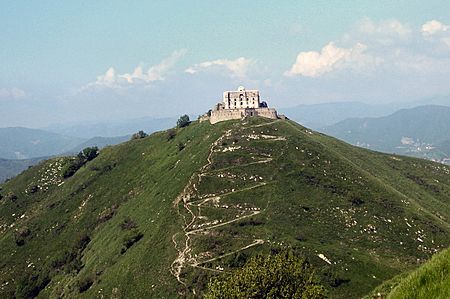Relief of Genoa facts for kids
Quick facts for kids Relief of Genoa |
|||||||
|---|---|---|---|---|---|---|---|
| Part of the Thirty Years' War | |||||||
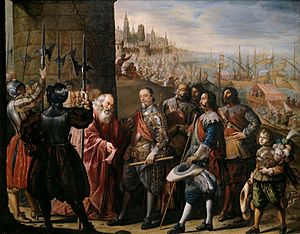 Relief of Genoa by the Marquis of Santa Cruz by Antonio de Pereda. Museo del Prado. |
|||||||
|
|||||||
| Belligerents | |||||||
| Commanders and leaders | |||||||
| Strength | |||||||
| 30,000 infantry 3,000 cavalry |
2,700–4,000 Spanish infantry (Genoa) 23 galleys 15,000 Spanish-Genoese (after the relief) |
||||||
| Casualties and losses | |||||||
| 5,000 dead or wounded 2,000 captured |
1,300 dead | ||||||
The Relief of Genoa was an important event during the Thirty Years' War. It happened between March 28 and April 24, 1625. This event involved a big naval operation by Spain to help the city of Genoa, which was under attack.
At the time, the city of Genoa, the capital of the Republic of Genoa, was being surrounded by a large army. This army had about 30,000 soldiers and 3,000 cavalry (soldiers on horseback). These forces were from France and the Duchy of Savoy. The Republic of Genoa was a long-time friend and ally of Spain.
The Spanish fleet, led by General Álvaro de Bazán, Marquis of Santa Cruz, arrived to help Genoa. They successfully freed the city from the siege. This action gave control of Genoa back to its own republic. It also forced the French and Savoyard armies to leave the area. After this, Spanish and Genoese forces worked together. They pushed back the French and Savoyard armies that had taken over parts of the Genoese Republic the year before.
Why the Battle Happened: Background
In the early 1600s, European powers often fought over land and power. Spain and France were two of the biggest rivals. The Thirty Years' War was a huge conflict that involved many countries.
Control of Important Routes
One key area of conflict was northern Italy. Spain wanted to protect its allies and important trade routes there. One of these was the "Spanish Road." This was a vital military route. It connected Spain's territories in Italy to its lands in Flanders (modern-day Belgium and Netherlands).
France, led by powerful figures like Cardinal Richelieu, wanted to challenge Spain's power. Richelieu formed alliances with other states, like Venice and Savoy, against Spain.
The Attack on Genoa
In 1624, France and Savoy decided to attack Genoa. Genoa was a rich port city and a strong ally of Spain. Attacking Genoa would hurt Spain's ability to move troops and money. It would also cut off the southern part of the Spanish Road.
The French and Savoyard armies moved quickly. They caught the Republic of Genoa by surprise. Most of the Genoese territory was taken over. Even reinforcements (extra soldiers) sent from Spain were stopped by French warships.
The French Threat to Genoa
The city of Genoa prepared for a fight. They increased their fleet of galleys (ships) and had about 11,000 soldiers ready. These soldiers included German mercenaries and local men. By February 1625, the invading armies were close to the city.
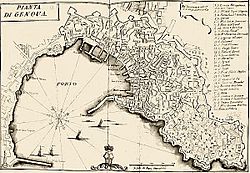
The French fleet tried to stop Genoa from communicating with Spain by sea. They even captured three Genoese ships carrying a lot of money. However, Spain had a stronger navy. This made it hard for France to completely block Genoa from the sea.
Despite the dangers, the Duke de Lesdigueres, a French commander, led an army of 23,000 men to surround Genoa. About a third of these soldiers were French.
Spain's Response and Relief of the City
Genoa put Carlo Doria, Duke of Tursi, in charge of its army. Spain ordered the Marquis of Santa Cruz to help Genoa. Spanish soldiers from Naples, including 2,000 elite infantry called tercios viejos, sailed to Genoa.
When Santa Cruz arrived, the people of Genoa were very happy. The Spanish soldiers, known for their toughness, quickly pushed back the French army. The French found themselves surrounded and the situation became too difficult. After about a month, the French and Savoyard forces had to retreat. The Spanish were able to take control of the city. This was very important for Spain's economy. Santa Cruz also attacked by sea, destroying three French warships.
Fighting in Piedmont
While Genoa was being relieved, fighting also happened in the Piedmont region. This area is between Genoa and Milan. French forces captured some towns but were slowed down by a siege at Gavi.
Meanwhile, Spanish forces under the Duke of Feria moved to help Genoa. They recaptured towns like Acqui, Gavi, and Novi. The French and Savoyard armies had to retreat further into Piedmont. The Duke of Feria continued to push them back. The combined French and Savoyard forces faced strong resistance from local Genoese fighters and Spanish troops. Eventually, the invaders were forced to leave the area and return across the Alps in November.
Taking Back the French Riviera
After Genoa was safe, the Genoese forces joined with the Spanish. They worked together to take back their lost lands along the coast, known as the French Riviera.
A fleet of forty galleys, led by Genoese and Spanish admirals, helped in this effort. By October, Genoa had recovered almost all of its territory. They even gained some new areas in Piedmont.
Santa Cruz successfully attacked and captured several forts and towns along the coast. These included Albenga, Port Maurice, and Ventimiglia. He also captured the biggest of the Lérins Islands, Île Sainte-Marguerite and Île Saint-Honorat. The Spanish held these islands until the French took them back in 1637.
What Happened Next
The relief of Genoa was a quick and successful operation for Spain. It showed how strong the alliance between Spain and Genoa was. The city's recovery and the continued arrival of Spanish silver shipments proved the value of this partnership.
However, not everything went Genoa's way. In October, Spain and France signed a six-month truce without asking their allies. This truce was also forced on Genoa and Savoy.
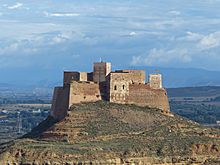
In early 1626, Spain and Genoa agreed to a new alliance. They promised to defend each other's lands. Genoa also agreed to provide soldiers and money to Spain. In return, Spain promised to attack Piedmont if Savoy attacked Genoa. If Milan (a Spanish territory) was attacked, Genoa would invade Piedmont from the south.
The Treaty of Monzón
In March 1626, France and Spain signed the Treaty of Monzón. This treaty officially ended the fighting between the Duke of Savoy and the Republic of Genoa. The treaty mostly brought things back to how they were before 1618. It gave control of the Valtellina valley back to the Vatican.
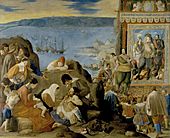
The Treaty of Monzón was a setback for Cardinal Richelieu of France. He was unhappy with the terms and avoided meeting the angry Savoyard ambassador. Savoy was left to make its own peace and even started looking for an alliance with Spain.
Spain had a very successful year in 1625. Besides relieving Genoa, they also:
- Regained Bahia in Brazil from the Dutch.
- Recaptured Breda in the Netherlands from the Dutch.
- Pushed back the English at Cadiz.
See also
- Second Genoese–Savoyard War
- Annus mirabilis



